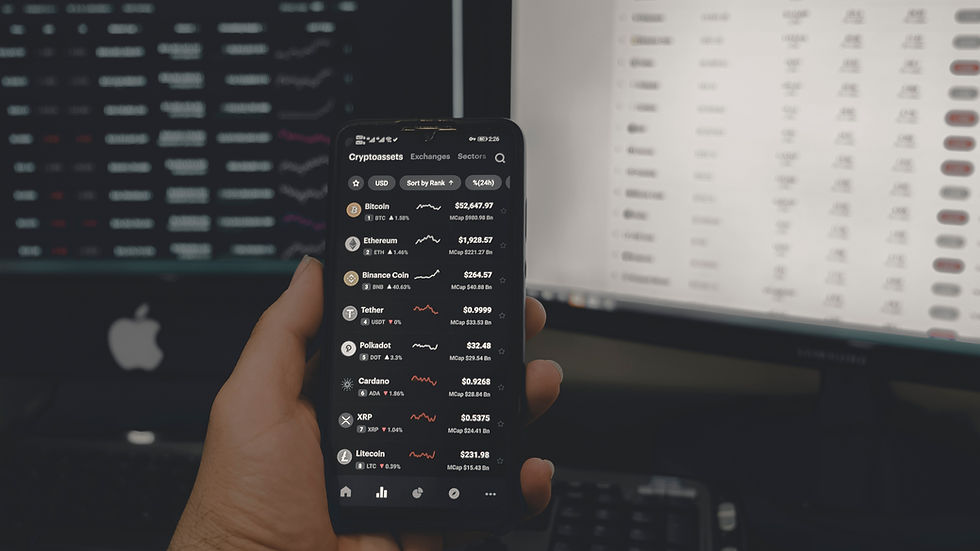Crypto Lending Platforms Compared: Best Rates for Staking vs. Borrowing
- Money Dox

- Jul 22
- 5 min read
Discover the top crypto lending platforms for staking and borrowing in 2025. Compare APYs, fees, security, and features to maximize returns and minimize costs.

1. Introduction
For crypto investors today, passive income or liquidity may involve lending and staking activities. Crypto lending allows users to earn interest from idle assets or borrow against their holdings. On the other hand, staking is where accounts with proof-of-stake (PoS) coins help provide network safety in exchange for rewards.
One needs to compare platforms for all the centralized and decentralized choices available, and this article delves into the parameters, rates, and special factors of the leading platforms. Such information would enable customers to select the one that works best for them.
2. What is crypto lending?
Definition and How It Works
Crypto lending platforms provide a bridge between lenders (who deposit assets) and borrowers (who post collateral to take loans). The lenders get interest, normally in the form of crypto, while the borrowers incur interest at rates based on parameters such as LTV.
Key Terms
APY: Annual Percentage Yield; the actual yield every year, bearing in mind the effect of compounding.
LTV: Loan-to-Value; the loan amount to collateral value ratio (i.e., in the case of 50% LTV, one could borrow $5,000 against $10,000 worth of BTC).
Collateral & Liquidation: Your positions will be liquidated to repay the loan if the collateral value falls below the maintenance threshold.
Centralized vs. Decentralized Lending
3. What is Staking in Crypto?
Definition and Rewards
Staking usually means locking PoS tokens (e.g., ETH, ADA, DOT) in order to validate transactions. For their efforts in maintaining the network, these validators earn an award usually paid in tokens.
Proof-of-Stake versus Lending
PoS Staking: A consensus at the level of the network; rewards vary according to network inflation and total stake.
Lending-based Staking: The platforms loan your tokens out to said validator nodes and, in return, share a portion of node awards, less fees.
Risks and Benefits
Benefits:
Passive income (usually 4-15% APY).
Contributes to securing and decentralizing the network.
Risks:
Slashing: Penalties are imposed if validators behave erratically.
Locked periods: Funds can sometimes be illiquid for days/weeks.
Platform fees: Centralized services may charge a commission against the rewards themselves.
4. Key Metrics to Compare Platforms
When evaluating platforms, focus on:
Interest Rates / APY
Staking APY: Range, compounding frequency, payout token.
Borrowing APR: Fixed vs. variable, promo rates.
Collateral Requirements
Minimum deposit size, supported collateral types.
LTV Ratios
Higher LTV unlocks more liquidity, but increases liquidation risk.
Supported Cryptocurrencies
Major coins (BTC, ETH), stablecoins (USDC, USDT), altcoins.
Fees & Penalties
Deposit/withdrawal fees, early‑unlock penalties, and network gas fees.
Security & Insurance
Custodial insurance, code audits, and regulatory compliance.
5. Top Crypto Lending Platforms Compared
Rates are approximate as of April 2025—always verify current APYs on each platform’s website.
6. Best Platforms for Staking: Highest Returns
Locked vs. Flexible:
Locked staking earns higher APY but keeps funds tied for a longer time.
Flexible staking has no withdrawal restrictions, which would better serve active traders.
For instance, staking 10 ETH on Nexo at a 10% APY earns you monthly payouts of about 1 ETH per year.
7. Best Platforms for Borrowing: Lowest Interest Rates
Stablecoin Borrowing Advantages:
Predicting rates and avoiding any volatility risk on the borrowed amount in crypto is possible.
Use Cases:
Leverage: Increase exposure without selling.
Liquidity: Gain access to capital for expenses and taxes.
Tax deferral: Maintain crypto positions while funding short-term needs.
8. Risks and Considerations
Market Volatility and Liquidation:
Always remember to use a conservative LTV ratio; in this case, less than or equal to 50%, as forced liquidation can occur upon a sudden fall in the price.
Smart Contract Risks (DeFi):
Should there be vulnerabilities or hacks, funds may be lost; always opt for audited protocols.
Regulatory Uncertainty:
The platform may choose to close down or deny access to user accounts based on new laws arising.
Platform Solvency (Centralized):
Audit report, insurance policy, and any previous cases of insolvency, such as BlockFi's restructuring of 2022.
9. Tips to Follow while Choosing the Right Platform
Assess Your Risk Appetite:
Lower APY with strong security vs. high APY with more risk.
Custodial or Non-Custodial:
Custodial platforms (CEXs) are somewhat convenient, while non-custodial platforms (DeFi) allow self-custody.
Match Your Goals:
Passive Income: Flexible staking is preferred with moderate APYs.
Active Leverage: Any platform that charges low borrowing rates and high LTV.
Gainsay Reputation and Transparency:
Third-party audits, on-chain metrics (for DeFi), user reviews, etc.
Diversify Across Platforms:
Diversifying across various platforms helps in counterparty risk reduction and different yield capture.
10. Conclusion
The answer is determined by your own investment goals and risk appetite for staking, borrowing, or a combination of both. Centralized platforms like Nexo and Crypto.com provide user-friendly interfaces and insurance, while DeFi giants like Aave and Compound offer transparency and potentially lower fees.
For staking, search for platforms offering flexible lock-ups and having good audits.
For borrowing, scout the stablecoin loans with an APR less than 5% and very conservative LTVs.
The most important point: Always conduct your research (DYOR) since rates and terms change constantly. Bookmark this guide, sign up for rate alerts, and remain on alert for greater profits in crypto, keeping your investments safe.



Comments